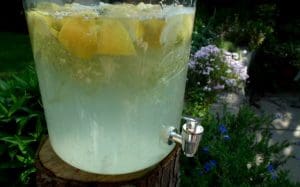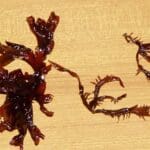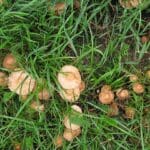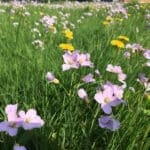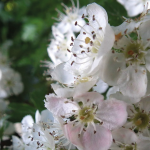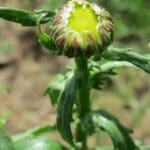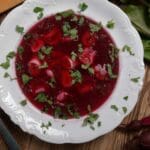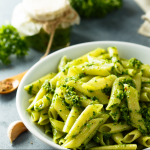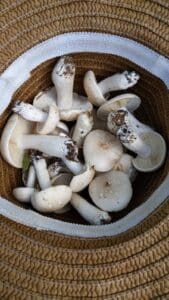Mayday traditionally marks the beginning of summer and May can often be one of the warmest and driest months of the year, foraging in May can be fruitful. Spring greens are still out in force and the warmer weather means the next wave of edibles is just beginning.
So what can you forage in May? Here are our top five picks for the month.
Hawthorn
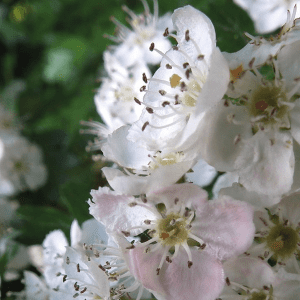
In May the hawthorn bushes are in full bloom. Their flowers are a signature of May and their thorny branches feature in May Day traditions all over the UK. The flowers have an amazing almondy flavour and are great added to salads, used in deserts or infused in alcohol.
Click here for the ID guide for Hawthorn.
Fairy ring champignons
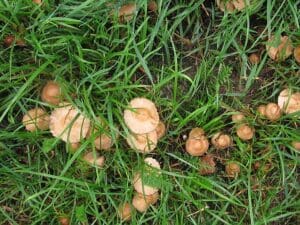
A lovely late spring, early summer time mushroom, They get their common name as they grow in rings. The rings can vary greatly in size depending on the age of the parent mycelium.
The mushrooms contain high levels of sugar called trehalose, which prevents cell damage when the mushrooms become extremely dry. So even if the weather does get hot they still tend to be in a good condition.
Click here for the ID guide for Fairy Ring Champignons.
Ox-eye daisy
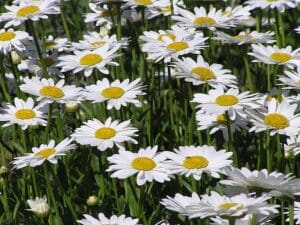
I think this is one of the best tasting flowering plants, the flowers and leaves are both edible and delicious.
I pickle the unopened flower buds and use them as a caper alternative.
When the flower buds have fully opened they are lovely dipped in a tempura batter and deep fried or they can be simply tossed through a fresh salad.
The young leaves have a strong herbal flavour when raw and I add them finely chopped to salads; they can also be cooked in a similar way to spinach.
Click here for the ID guide for Ox Eye Daisy
Irish sea moss or Carrageen
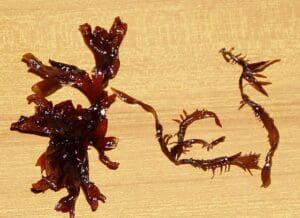
Carrageen is an increasingly popular seaweed due to its immune boosting properties, it can be found along most of the British coastline and it’s easy to ID. It’s a seaweed that most of us will have eaten perhaps unknowingly as it’s used a lot as a vegan thickener or stabiliser and appears in vegan milks, toothpaste and beers.
Click here for the ID guide for Carrageenan.
Ladies Smock
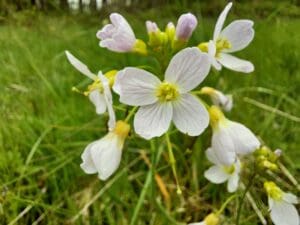
A common member of the Cabbage family is at its best in spring. The flowers and leaves have a spicy, horseradish type flavour that works well in a variety of dishes. Normally found in meadows, where it gets established it can become hyper abundant.
Click here for the ID guide for Ladies Smock.
Recipe of the month for Foraging in May
Carrageen Pudding
This is a traditional Irish recipe that’s quite similar to an Italian panna cotta.
Ingredients
10g dried carrageen moss
600ml milk
1 vanilla pod
1 large egg, separated
30g caster sugar
300ml double cream
Instructions
Soak the carrageen in warm water for about 10 minutes until it softens.
Drain off the water and place the seaweed in a saucepan with the milk.
Split and scrape the seeds of the vanilla pod into the milk and add the pod too. Bring to the boil and simmer gently for 10 minutes.
Put the egg yolk into a bowl with the sugar and mix well with a whisk.
Strain the milk mixture onto the egg yolk, pushing through all the jelly-like, swollen moss with the back of a spoon.
Add the cream and leave to cool, then pour into individual ramekins and refrigerate for 30 minutes or so until set.
I like to serve mine with a fresh coulis made from wild berries.
Click here for more Spring recipes
What to forage in April.
Foraging in April, it’s one of my favourite months to forage, the warming temperatures make everything burst to life. It’s the month for fresh spring greens and herbs but there are also a few gourmet mushrooms too.
What to forage in June.
Foraging in June can be really variable weather-wise, one day it’s hot and humid and the next day it’s damp and miserable. The summer solstice is towards the end of the month when the sun reaches its highest point, it’s an important time in the foraging calendar.
